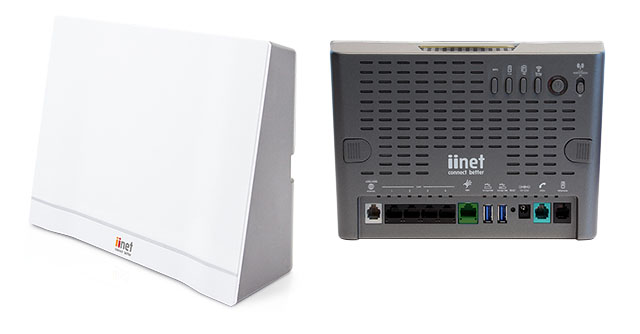
blog They’re not everyone’s cup of tea, but iiNet’s own-branded ADSL modems (the BoB and Budii lines) which the national broadband provider has developed can be found in the houses and small business premises of many, many Australians. The modems’ solid performance coupled with stylish design, easy administration and, most of all, subsidised nature on iiNet broadband plans has made them a winner. Introducing this standardised line has also made it much easier for iiNet to administer its customers’ broadband connections.
Late last week the company announced the latest in the line — the Budii Lite. While it still maintains a similar form factor as the previous high-end Budii ADSL modem, it does so in a smaller form factor. In addition, it comes with a bunch of new features not always found in consumer modems — 802.11ac wireless access, four gigabit LAN ports and a Gigabit WAN port, making the modem suitable for connection to NBN Co’s fibre infrastructure, should your area be lucky enough to receive it. The full tech specs can be found online.
I know that mentioning consumer-grade modems such as the Budii Lite on Delimiter can be fraught with danger — many readers, including myself, prefer more flexible and powerful options such as FRITZ!Box, Linksys or even Cisco. However, I wanted to flag this as something that readers may especially find useful to recommend to friends and family. I get constantly asked by personal connections for broadband recommendations.
Over the past several years, if the questioner is outside the HFC cable or NBN footprints my recommendation has consistently been to pair an iiNet ADSL connection with a Bob Lite modem, as this is the setup which seems to feature the best combination of customer service, service consistency, price and stability. I suspect I will shortly switch that recommendation to the Budii Lite modem. It’s pretty future proof, and at $99 on a two year contract it’s a pretty good deal. And no, iiNet’s not paying me to write this ;)
Image credit: iiNet

Is it going to have the same port forwarding problems that the BoB2 has?
I’ve got a bob2, and its a piece of crap. a $50 TP-link has better performance and features.
maybe this one will change things, but iinet has had some pretty crappy routers in the past, usually not worth touching.
Pretty amusing you would claim something like iiNet BoB devices to be unreliable and use TP-Link as a comparison. Maybe you’ve been lucky – most people are really only aware of quality in relation to personal experience. In my experience 90% of TP-Link devices I’ve seen have been replaced under warranty (and a fair amount of those then went on to fail, too). But good luck to you if yours has been good.
Proper edge routers are the only way to go if you want reliable stability, pretty much every consumer product out there is junk from a consistent reliability point of view. Although I keep hearing good things about the EdgeMAX Lite, which is in consumer grade price territory but supposedly up to the task of entry-level Cisco or Juniper gear. I haven’t seen enough of them to draw a meaningful conclusion about that myself yet, so caveat emptor, but it may be a way for those budget sensitive to improve reliability relatively painlessly (well, assuming you can set one up, of course – one reason consumer gear will always be a better fit for consumers is the limited complexity of such devices despite the tradeoffs).
I’ve had a lot of TP-Link stuff (most of it re-flashed with OpenWRT or CeroWRT) for low-cost mesh networks and also for travel, and I haven’t had any failures so far.
I also have a Ubiquiti EdgeMax ER-Lite – they’re pretty damn good. Thinking of getting a Pro as well (the one with like eight ports and two SFP ports for fibre) because they’re damn cheap. For certain things they’re actually a lot faster than entry level Cisco stuff. A lot of the lower cost Juniper and Cisco gear is actually pretty crap performance wise. You have to pay the big bucks for the higher performance models if you want high speed forwarding when the firewall is on.
Yea we’ve been using their wifi devices for a while, they are bulletproof. The EdgeMAX beat the pants off the competition for performance and several reviews have backed up those claims with real world numbers, and I’m hearing more and more that they’re rock solid from people in the field so we’re going to start evaluations soon.
As for TP-Link I have zero experience deploying aftermarket or community firmware, you just don’t do that for customer sites. I wouldn’t be at all surprised to find replacing the stock firmware makes them much more reliable either – there’s nothing intrinsically wrong with the hardware design (from a consumer perspective, but there are plenty of businesses out there using $50 consumer modems and wondering why they keep falling over with 60 users all hammering away, or a dozen simultaneous VPN connections).
As anecdotal experience goes, I’ve always found the TP Links to be good cheap and cheerful devices. I’ve had one DoA, but I’ve had that with Numerous brands.
As for the smaller end of the scale, I’ve always liked Draytec gear for reliability. But you can get a Juniper for not too much money these days if you want something more enterprise grade.
I think iiNet should put different pictures on the back for the different NBNs the Budii Lite can connect to. A nice speedy rabbit for FTTP, and big red question mark for FTTN and perhaps two big question marks for HFC, followed by some @#*&!.
Minor correction: Dlink, Linksys (and I assume fritzbox) are consumer devices also. :-)
Honestly, I still prefer a separate modem and firewall (normally a MikroTik RB2011UiAS-RM unit for businesses and the RB951G-2HnD for home users). The MikroTik units are seriously powerful and configurable.
Comments are closed.